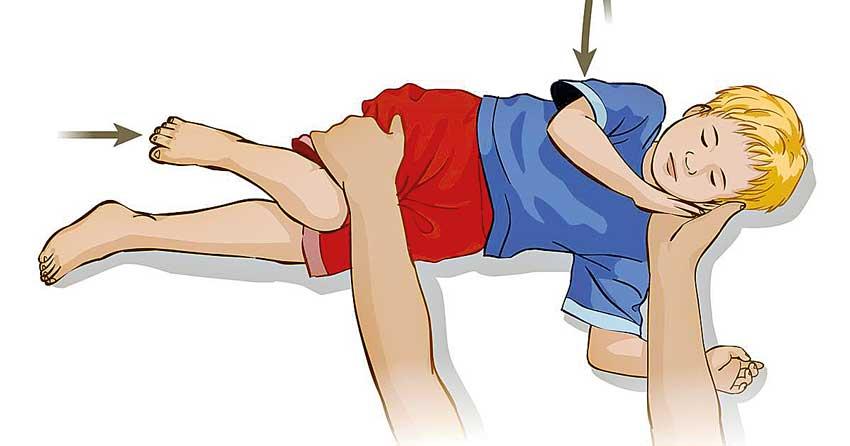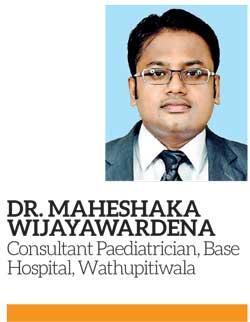Reply To:
Name - Reply Comment

 A previously healthy child suddenly developing a seizure attack will be a nightmare for a parent. But that is exactly what happens in a child having febrile convulsions, also known as ‘febrile fits, which is the commonest condition causing seizure attacks in children. Though it is common, there are many myths associated with febrile fits. So how should you as a parent cope if your child suddenly developed a seizure associated with a fever? Health Capsule consulted Dr.MaheshakaWijayawardena, Consultant Paediatrician, Base Hospital, Wathupitiwala, to obtain information on the subject.
A previously healthy child suddenly developing a seizure attack will be a nightmare for a parent. But that is exactly what happens in a child having febrile convulsions, also known as ‘febrile fits, which is the commonest condition causing seizure attacks in children. Though it is common, there are many myths associated with febrile fits. So how should you as a parent cope if your child suddenly developed a seizure associated with a fever? Health Capsule consulted Dr.MaheshakaWijayawardena, Consultant Paediatrician, Base Hospital, Wathupitiwala, to obtain information on the subject.
A convulsion associated with fever
Febrile seizures occur as a response of the developing brain to high fever, explains Dr. Wijayawardena. A febrile seizure can be defined as a convulsion associated with fever, occurring in a developmentally normal child with no evidence of infection of the central nervous system (eg: Meningitis)
Most of the children who experience febrile convulsions have predisposing family histories of febrile seizures, mostly on the child’s maternal side.

Children of age 6 months to 6 years are the usual age group susceptible to febrile convulsions. Out of this age group, most seizures tend to occur when the child is 12 to 18 months of age. As mentioned earlier, febrile convulsions are always associated with fever. The cause for the fever may vary from an Upper respiratory tract infection like a cold or tonsillitis, a urinary infection, diarrhoeal infection to even more serious infections like pneumonia or dengue fever. Fever following immunization can also predispose to febrile seizures.
Febrile convulsions can be categorised as typical or atypical, depending on the presentation. A typical febrile convulsion usually occurs during the first 24 hours of fever, is short lasting (less than five minutes), and only one episode occus for one fever episode. Febrile convulsions that deviate from the above are categorised as atypical.
“Most parents assume that febrile convulsions occur with ‘high’ fever”, states Dr. Wijayawardena. But the intensity of the fever is not always associated with the occurrence of the convulsion. “Sometimes, seizures can occur without a high temperature, fever only occurring after the convulsion”, he explains.
Investigating a child with fever fits
As febrile convulsions is a clinical diagnosis, no special investigations are needed in diagnosing febrile convulsions, according to the doctor. Electro Encephalogram or EEG, or brain imaging like MRI or CT is not indicated in a child diagnosed to have a febrile convulsion. But children who are very ill, with high fever should undergo investigations to exclude severe infections of the nervous system like meningitis. Other causes of seizures like low blood sugar, blood electrolyte imbalances and ingestion of toxins need to be excluded before arriving on a definitive diagnosis.
Management
The management of febrile convulsions is mainly based on controlling the fever of the child. This can be done through giving regular doses of paracetamol according to the body weight (15 mg/kg), for the first 48 hours of fever in a child with a history of febrile convulsions. As Sri Lanka is experiencing a dengue epidemic, Non Steroidal Anti Inflammatory drugs like Ibuprofen or Mefenemic acid should be avoided as much as possible.
Tepid sponging of the child can be done, even though there is no scientific evidence that it reduces the risk of convulsions. This could be done by wetting a cloth with room temperature – water, and wiping the areas with large blood vessels, like neck, axilla and inguinal area. Sponging of the whole body should not be carried out as it may lead to an increase of the core temperature, predisposing to another convulsion, the doctor cautions.
Risk of recurrence
Children with a single episode of short lasting febrile convulsion do not need special medication. But, children who are having recurrent seizures or a history of seizures lasting for more than 5 minutes, might need special medication, to be used when they have a fever.
About 30% of the children who have one episode of febrile seizures go on to have further febrile seizures. These do not occur with every fever that the child might get. While witnessing your child go through a seizure episode is a scary experience for a parent, it is very unlikely that the seizure can cause long lasting damage like impairment of intelligence or brain damage to your child, reassures Dr. Wijayawardena.
Take home message
In children who have had febrile fits in the past, it’s important to control the fever in the first two days. A child with first episode of febrile seizure, a child having more than one episode of seizure or long lasting seizures and abnormal seizures like seizing of only one side of the body, will require hospitalization. Proper knowledge of managing a seizure by caregivers at home is vital. A child with febrile convulsions is unlikely to have any long lasting effects.
Turn the convulsing child laterally to his left side. This position minimizes the risk of aspiration in the child.
Avoid putting anything in child’s mouth. Check the time.
A febrile seizure will usually resolve within a few minutes.
If the seizure lasts more than five minutes, take the child to the nearest hospital in the same position, as he may need medical intervention to stop the seizure.